#CES Advent
Text
CES pitches and invitations could really use a lid
It's crazy that CES PR types have been waiting until today to pitch me for the first time on their employers or clients. There's gotta be a cutoff date for those solicitations, and I'm saying it will be close of business Monday.
In less than three and a half weeks, I will fly to Las Vegas to cover CES. Because I’ve now done that 25 times, I know that I should have my schedule set by now–and yet I don’t, because I continue to get pitches and invitations for the gadget gathering.
And many of the 61 e-mails I received Thursday alone (going by a search for “CES” in the subject line of messages that aren’t replies to my own…

View On WordPress
#calendar#ces#CES Advent#consumer electronics show#full lid#Las Vegas#lid#pitches#PR#schedule#tech show#Vegas
0 notes
Text
It’s Saturday, Day 13 of THE LATEST LITERACY WALLCHART FOR CHILDREN advent calendar!

I think this is the best piece of advice that the WALLCHART has to offer, hands down. Sweet potato is a pretty wise day too, but if I was able to give just one singular piece of advice to a person who was totally new to fruits and vegetables, I think that making sure that they could distinguish between a sweet potato and a regular potato would be a MUCH lower priority than preventing them from biting into a banana that has its clothes still on. Right?
#part of the reason that i typed ‘one singular piece’#is that the godforsaken jp iphone#autocorrects ‘one pi*ce’ to ‘ONE PIECE’#i don’t even watch anime. i really hate it here sometimes#anyway.#THE LATEST LITERACY WALLCHART FOR CHILDREN#advent calendar
29 notes
·
View notes
Text
Someone on Reddit made the mistake of saying, "Teach me how this conflict came about" where I could see it.
Let me teach you too.
The common perception is that Jews came out of nowhere, stole Palestinian homes and kicked Palestinians out of them, and then bombed them for 75 years, until they finally rebelled in the form of Hamas invading Israel and massacring 22 towns in one day.
The historical reality is that Jews have lived there continuously for at least 3500 years.
There are areas, like Meggido iirc, with archeological evidence of continuous habitation for 7,000 years, but Jewish culture as we recognize it today didn't develop until probably halfway through that.
Ethnic Jews are the indigenous people of this area.
Indigeneity means a group was originally there, before any colonization happened, and that it has retained a cultural connection to the land. History plus culture.
That's what Jews have: even when the diaspora became larger than the number of Jews in Israel, the yearning to return to that homeland was a daily part of Jewish prayer and ritual.
The Jewish community in Israel was crushed pretty violently by the Roman Empire in 135 CE, but it was still substantial, sometimes even the majority population there, for almost a thousand years.
The 600s CE brought the advent of Islam and the Arab Empire, expanding out from Saudi Arabia into Israel and beyond. It was largely a region where Jews were second-class citizens. But it was still WAY better than the way Christian Europe treated Jews.
From the 700s-900s, the area saw repeated civil wars, plagues, and earthquakes.
Then the Crusades came, with waves of Christians making "pilgrimages to the Holy Land" and trying to conquer it from Muslims and Jews, who they slaughtered and enslaved.
Israel became pretty well depopulated after all that. It was a very rough time to live there. (And for the curious, I'm calling it Israel because that's what it had been for centuries, until the Romans erased the name and the country.)
By the 1800s, the TOTAL population of what's now Israel and Palestine had varied from 150,000 - 275,000 for centuries. It was very rural, very sparsely populated, on top of being mostly desert.
In the 1880s, Jews started buying land and moving back to their indigenous homeland. As tends to happen, immigration brought new projects and opportunities, which led to more immigration - not only from Jews, but from the Arab world as well.
Unfortunately, there was an antisemitic minority spearheaded by Amin al-Husseini. Who was very well-connected, rich, and from a politically powerful family.
Al-Husseini had enthusiastically participated in the Armenian Genocide under the Ottoman Empire. Then the Empire fell in World War One, and the League of Nations had to figure out what to do with its land.
Mostly, if an area was essentially operating as a country (e.g. Turkey), the League of Nations let it be one. In areas that weren't ready for self-rule, it appointed France or Britain to help them get there.
In recognition of the increased Jewish population in their traditional, indigenous homeland, it declared that that homeland would again become Israel.
As in, the region was casually called Palestine because that was the lay term for "the Holy Land." It had not been a country since Israel was stamped out; only a region of a series of different empires. And the Mandate For Palestine said it was establishing "a national home of the Jewish people" there, in recognition of "the historical connection of the Jewish people with Palestine and to the grounds for reconstituting their national home in that country."
Britain was appointed to help the Arab and Jewish communities there develop systems of self-government, and then to work together to govern the region overall.
At least, that was the plan.
Al-Husseini, who was deeply antisemitic, did not like this plan.
And, extra-unfortunately, the British response to al-Husseini inciting violent anti-Jewish riots was to put him in a leadership role over Arab Palestine.
They thought it would calm him down and perhaps satisfy him.
They were very wrong.
He went on to become a huge Hitler fanboy, and then a Nazi war criminal. He co-created the Muslim Brotherhood - which Hamas is part of - with fellow fascist fanboy Hassan al-Banna.
He got Nazi Party funding for armed Muslim Brotherhood militias to attack Jews and the Brits in the late 30s, convincing Britain to agree to limit Jewish immigration at the time when it was most desperately needed.
He started using the militias again in 1947, when the United Nations voted to divide the mandated land into a Jewish homeland and a Palestinian one.
Al-Husseini wouldn't stand for a two-state solution. He was determined to tolerate no more than the subdued, small Jewish minority of second-class citizens that he remembered from his childhood.
As armed militias increasingly ran riot, the Arab middle and upper classes increasingly left. About 100,000 left the country before May 1948, when Britain was to pull out, leaving Israel and Palestine to declare their independence.
The surrounding nations didn't want war. They largely accepted the two-state solution.
But al-Husseini lobbied HARD. And by mobilizing the Muslim Brotherhood to provide "destabilizing mass demonstrations and a murderous campaign of intimidation," he got the Arab League nations to agree to invade, en masse, as soon as Britain left.
About 600,000 Arabs fled to those countries during the ensuing war.
Jews couldn't seek refuge there; in fact, most of those countries either exiled their Jews directly, confiscating their property first, or else made Jewish life unlivable and exploited them for underpaid or slave labor for years first.
By the time the smoke cleared and a peace treaty was signed, most of the Arab Palestinian community had fled; there was no Arab Palestinian leadership; many of the refugees' homes and businesses had left had been destroyed in the war; and Israel had been flooded with nearly a million refugees from the Arab League countries and the Holocaust - even more people than had fled the war.
That was the Nakba. The one that gets portrayed as "750,000 Palestinians fled or were expelled!" in the hope that you'll assume they were expelled en masse, their beautiful intact homes all stolen.
Egypt had taken what's now the Gaza Strip in that war, and Jordan took what's now the West Bank - expelling or killing all the Jews in it first.
(Ironically, Jordan was originally supposed to be part of Israel. Britain, inexplicably, cut off what would have been 75% of its land to create Jordan.
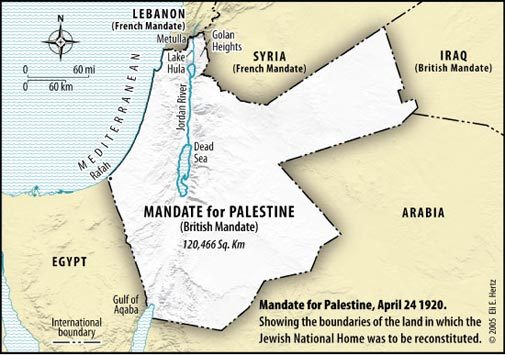
Even more inexplicably, nobody ever talks about it. I've never seen anyone complain that Jordan was stolen from Palestinians. Possibly because Jordan is also the only country that gave Palestinian refugees full citizenship, and it's about half Palestinian now.
Israel is nearly 25% Arab Palestinians with full citizenship and equal rights, so it's not all that different -- but the fundamental difference of living in a country where the majority is Jewish, not Muslim, probably runs pretty deep.)
Anyway: that's why Palestine is Gaza and the West Bank, rather than being some contiguous chunk of land. Or being the land set aside by the U.N. in 1947.
Because Arab countries took that land in 1948, and treated them as essentially separate for 20 years.
Israel got them back, along with the Golan Heights and the Sinai Peninsula, in the next war: 1967, when Egypt committed an act of war by taking control of the waterways and barring Israel from them. It gave the Sinai back to Egypt as part of the 1979 peace accords between Egypt and Israel.
Israel tried to give back the Gaza Strip at the same time. Egypt refused.
Palestine finally declared independence in 1988.
But Hamas formed at about the same time. Probably in response, in fact. Hamas is fundamentally opposed to peace negotiations with Israel.
Again: Hamas is part of a group founded by Nazis.
Hamas has its own charter. It explains that Jews are "the enemy," because they control the drug trade, have been behind every major war, control the media, control the United Nations, etc. Basic Nazi rhetoric.
It has gotten adept at masking that rhetoric for the West. But to friendlier audiences, its leaders have consistently said things like, "People of Jerusalem, we want you to cut off the heads of the Jews with knives. With your hand, cut their artery from here. A knife costs five shekels. Buy a knife, sharpen it, put it there, and just cut off [their heads]. It costs just five shekels."
(Palestinians were outraged by this speech. Palestinians, by and large, absolutely loathe Hamas.
It's just that it's not the same to say that to locals, as it is to say it where major global powers who oppose this crap can hear you.)
Hamas has stated from the beginning that its mission is to violently destroy Israel and take over the land.
It has received $100M in military funding annually, from Iran, for several years. Because Iran has been building a network of fascist, antisemitic groups across the Middle East, in a blatant attempt to control more and more of it: Hezbollah in Lebanon. The Houthis in Yemen.
Iran has been run by a very far-right, deeply antisemitic dictatorship for decades now, which pretty openly wants to take down both Israel and the U.S.
Last year, Iran increased Hamas's funding to $350M.
The "proof of concept" invasion of Israel that Hamas pulled off on October 7th more than justifies a much bigger investment.
Hamas has publicly stated its intention to attack "again and again and again," until Israel has been violently destroyed.
That is how this conflict came about.
A Nazi group seized power in Gaza in 2007 by violently kicking the Palestinian government out, and began running it as a dictatorship, using it to build money and power in preparations for exactly this.
And people find it shockingly easy to believe its own hype about being "the Palestinian resistance."
As well as its propaganda that Israel is not actually targeting Hamas: it's just using a literal Nazi invasion and massacre as an excuse to randomly commit genocide of the fraction of Palestine it physically left 20 years ago.
Despite the fact that Palestinians in Gaza have been protesting HAMAS throughout the war.

#free palestine#free gaza from hamas#free everyone from hamas it's awful#we want to live movement#free gazans group#center the people directly affected#Ironically it's almost exclusively zionists who know about and support the actual activists in Palestine#because Zionism is a real Jewish term for self-determination not something you can redefine to demonize us#and the pro-hamas movement is inherently both antisemitic and anti-Palestinian#wall of words#jumblr#jewish history#palestinian history
820 notes
·
View notes
Text


Last week something happened. A strange feeling that I had forgotten, buried deep within my being. I watched FFVII Rebirth and my heart exploded in mid-flight, aboard the Tiny Bronco. I was suddenly propelled back almost 20 years, to the time when I discovered the game, to the time of Advent Children which had given me a cosmic slap in the face. These two resurfaced from the depths of my being, took me by the hand and led me into their adventures with all the fantasies that it aroused in me. I feel like Vincent waking up from a long sleep, and connecting with myself. I'm getting back to writing. I write about them. My desires for drawings are made only of them. I live again. I find this bit of madness and excitement that had abandoned me following several burnouts and depression. This illustration is just the beginning. The start of a new adventure.
***********
La semaine dernière il s'est passé quelque chose. Une drôle de sensation que j'avais oublié, enfoui au plus profond de mon être. J'ai regardé FFVII Rebirth et mon cœur à exploser en plein vol, à bord du Tiny Bronco. J'ai été brutalement propulsé presque 20 en arrière, à l'époque où j'avais découverte le jeu, à l'époque d'Advent Children qui m'avait foutu une claque cosmique.
Ces deux là on ressurgit du fin fond de mon être, m'ont pris par la main et mon entrainé dans leurs aventures avec tout les fantasmes que cela suscitait en moi. Je me sens comme Vincent se réveillant d'un long sommeil, et me connectant à moi même.
Je me remet à écrire. J'écris sur eux. Mes envies de dessins ne sont fait que d'eux. Je revis. Je retrouve ce brin de folie et d'excitation qui m'avait abandonné suite à une plusieurs burn out et dépression.
Cette illustration n'est que le début. Le début d'une nouvelle aventure.
#ff7 rebirth#ff7#fanart#final fantasy#final fantasy 7#final fantasy vii#vincent valentine#cid highwind#valenwind#my fanart
59 notes
·
View notes
Text

Jar in the Shape of a Monkey
Aztec, Late Postclassic, 1300-1520 CE
The spider monkey’s popularity as a subject on stone vessels may relate to the saga of a failed creation, in which monkeys featured importantly, before the advent of true humans, or perhaps it alludes to the playful character of the patron deities of artisans. The association with a human burial of the only vessel with reliable archaeological context, however, strengthens a still-unresolved symbolic relationship between death and the monkey. Such a link has been noted in codical studies: in the Maya Dresden Codex, the monkey is invariably represented with death symbols, something equally applicable to such non-Maya books as the Codex Vienna or Codex Laud. The manufacture of vessels in the shape of a monkey using travertine may have had its source of inspiration in the much older production of similar forms in ceramics.
47 notes
·
View notes
Note
And another question re: Gaelic post…can you talk more about Scots, and how it came to be seen as the more “educated” language compared to Gaelic, as well as how the language is viewed now?
Barrie quaisten!
SCOTS
Scots is another Anglic language closely related to English. There is heated debate (often, unfortunately, along political party lines) over whether it should be considered a language or a dialect. However, the linguistic consensus is that Scots is indeed its own distinct language, complete with its own vocabulary, grammar rules, and historical character. It's akin to the relationship between Danish and Norwegian - while they share a relatively recent common ancestor and have influenced each other over the course of history (however lop-sided that influence may be), they are indeed separate languages.
Around the 600s CE, a new language appeared in the southeast corner of Scotland, back when this area was under the control of certain new-ish arrivals to the island who spoke a Germanic tongue. At this point, Middle Irish (modern Gaelic's immediate ancestor) was the court language of Scotland, and would remain so until the reign of David I, crowned in 1124. Scots is said to have begun diverging from the Northumbrian Old English dialect in earnest by the 1100s, although records of the language are sparse before about 1375 (the beginning of the Early Scots literary period) owing to Viking and English "meddling" (some light raiding here, some plundering there, general theft, and so on). Owing to its Northumbrian origin and heavier Scandinavian influence (stemming from close ties with the Danelaw), Scots has more of an Anglian and Norse character to it as opposed to its relatively more Saxon-y, Norman-y cousin to the south (i.e., English). Scots has also had much closer contact with languages like Scottish Gaelic and even Pictish and Cumbric (which I'll be sure to cover in a future post), and as a result has been influenced in its vocabulary and phonology.
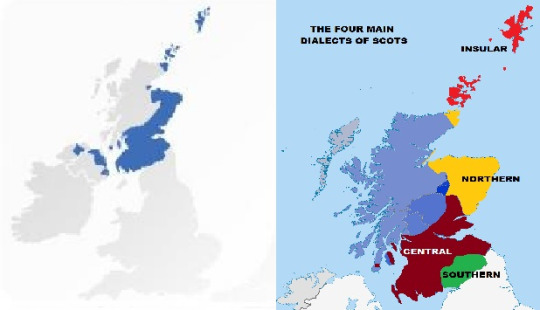
It has several dialects of its own, broadly categorized by location, ranging from Borders Scots to Orcadian Scots and everything in between. (And we can't forget Ulster Scots, a dialect brought to Ulster during the 1600s by Lowlander planters.) Due to this variation, modern Scots has no clear standardized form, though linguists have made several halfway-serious attempts over the past century or so to standardize orthography.
But what's been going on with Scots between David I and the present day? Let's dig in.
David I (in Gaelic, Daibhidh I mac Mhaoil Chaluim), who reigned from 1124 to 1153, initiated the proliferation of proto-urban societies across his kingdom. These societies were called "burghs", or "touns" in Scots, and they'll come in handy later. At about this same time, Norman French began to infiltrate the Scottish nobility, and Gaelic began to decline as a language of prestige among higher levels of society.
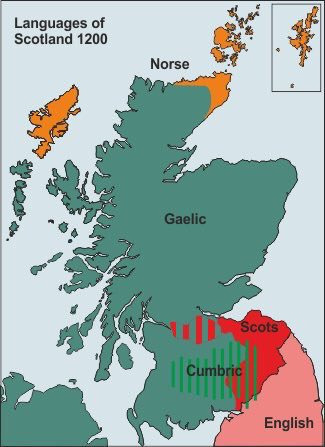
Once the 1200s started to creep around, the northern dialect of Early Middle English that would become Scots began expanding ever northward towards the Forth-Clyde line. This dialect was called "Inglis" by its speakers, and over the next century, it began to supplant Norman French and Gaelic as a common language within the burghs. The 1300s saw this "Inglis" tongue grow in prestige and it began to eclipse Norman French at even the higher levels of society, particularly within the courts. As the 1400s approached, it even began to replace Latin as the language of ecclesiastical and royal court proceedings.
The 1400s saw a relatively rapid geographic spread of Scots at the expense of Gaelic, which was cornered into the Highlands, Western Isles, and small pockets in the Lowlands (viz. Galloway, where Gaelic survived at least up to 1760). By the early 1500s, Scots began to be known as "Scottis", and Gaelic, which had previously been referred to thus, was now being dubbed "Erse" ("Irish") in attempts to otherize Gaelic. The 1500s saw the advent of Middle Scots, which was, in my amateur opinion, the golden era of the language, owing to its undisputed support at all levels of society across most of the kingdom. Around this time, a loose written standard did exist, but the language was still written how it sounded and regional variation was commonplace.

1567, however, saw the coronation of James VI of Scotland (note: James I of England and Ireland as well from 1603 on). His famous Bible translation (KJV) helped to set in motion the gradual Anglicization of Scottish society as it was dispersed among the population. In 1603, the Union of the Crowns brought Scots-speaking and English-speaking nobles into closer contact, and English gradually began to dominate the speech of the Scottish nobility (this exchange would produce what is now Scottish English, a distinct standardized dialect of English that some argue is one end of a linguistic spectrum, at the other end being "braid Scots").
Beginning in 1610 and continuing through to the 1690s, Scottish planters from across the western Lowlands and the Borders began to settle in Ulster, the northeastern region of Ireland. Over time, this group of people would come to develop their own regional identity, the Ulster Scots (or, often in a New World context, Scots-Irish). Their local dialect of Scots, while maintaining a Lowland character, picked up various influences from Hiberno-English (particularly in phonology) and from the Irish language (various contributions of vocabulary).

By about 1700, written Scots, at least in an official capacity, had become almost completely Anglicized. An example of an Anglicized convention introduced to Scots writing is the "apologetic apostrophe", an apostrophe that was inserted into a Scots word where an English-speaking person might expect a letter to be (for example, the Scots word "wi" (in English, "with") would have been written wi'). In 1707, the Acts of Union (Note: Panama played a role) seemed to solidify a shift in the upper-class opinion of the Scots language - what scarcely 150 years before was seen as the national language was now looked down upon by the nobility as "uneducated speech" or "bad English".
However, things looked different from a lower- and middle-class perspective. Contrary to high society, the common people began to take a renewed interest in the Scots language, and a literary revival began. This mid-1700s revival gave us such world-famous names as Robert Burns, Walter Scott, and Thomas Campbell. It was at this time that Scots transitioned from Middle to Modern Scots. However, features such as the apologetic apostrophe were retained during this period to gain wider readership among an English-speaking audience, a market that now effectively spanned the globe. (Meanwhile, the Highlands and Lowlands each experienced their own set of Clearances, and Scotland's diaspora began their journey to the edges of the empire.)
By the early 1800s, this "Scots fever" (NOTE: not a technical term) had reached the upper classes of society as they increasingly turned a Romanticist eye to the literature of their homeland, while simultaneously keeping Gaelic at arm's length. Since this point, there hasn't been any sort of top-level, government-sanctioned, institutional spelling reform or rulebook published on Scots orthography, although this hasn't stopped a wealth of Scots poetry and prose from being published through the years.
Since this era, there has been a relatively steady stream of interest in the language, though recent government initiatives have been taken to attempt to ensure the survival of, and increase interest in, Scots. This 2010 study by the Scottish Government sheds some light on modern public perception of the language within Scotland itself.

Over in Northern Ireland, the Ulster-Scots Agency was established as part of the wider Belfast Agreement of 1998 in efforts to promote the language and wider culture.

It's not all roses these days, however. A couple of years ago, it came to light that a North Carolina teenager had been, for over seven years, writing entries on the Scots Wikipedia, without any knowledge of the language. One Reddit user remarked that this teenager had caused "more damage to the Scots language than anyone else in history." (Perhaps take this with a grain of salt.)
Would you like to help protect the language?
The best way to protect a language is to learn it! If you click that link, there are several resources for adult learners of Scots to start their journey. My perennial advice, though: once you've got the basics down, use it! Find a Scots speaker and stumble your way through a conversation. Don't be afraid of making mistakes! (Note: everyone makes them.) One resource I've used in the past to learn some basics is the Open University's (entirely free!) Scots language and culture online course. All you need to do is sign up and work through the modules!
Follow for more linguistics and share this post! If you have any questions, feel free to ask!
#scots#scotland#germanic#language#languages#learning languages#langblog#langblr#indo european#united kingdom#ireland#northern ireland#ulster
217 notes
·
View notes
Text
Basic history of paganism
Please note: I am pagan and I am writing this as neutral as I can. But I'm giving facts and history. This does not mean I don't respect other beliefs and religions, because I absolutely respect them! and think everyones faith is unique and beautiful in they're own ways.

What the word Paganism means and why it was used-
Paganism is a Christian phrase that refers to faiths that do not worship the God of Abraham, who is essential to Christianity as well as other Abrahamic religions such as Judaism and Islam. Christians have used the labels paganism and pagan, which have negative connotations, to distinguish themselves from others who they think worship false gods.
Throughout much of Christianity's history, few, if any, of those labelled heathen have accepted this term for themselves. However, since at least the first part of the twentieth century, the term has been reappropriated as a self-description by a group of similar new faiths. They are sometimes referred to as modern Pagan or Neo-Pagan organisations and are influenced by religions from Europe, North Africa, and West Asia that became extinct as a result of the advent of Christianity and other Abrahamic faiths.

The history-
Christianity appeared in the Roman Empire in the first century CE. As a monotheistic religion, it held that there was only one genuine God, whom it identified as the God of Abraham, a divinity also revered in Judaism. The majority of the empire's traditions were polytheistic, with several gods and goddesses. For Christians, polytheistic cultures were idolatrous, with deities who were actually devils. This perspective made it difficult for many Christians to seek peaceful coexistence with non-Abrahamic religions.
One hypothesis is that the word pagani, which means "people of the place," came to apply to individuals who continued to worship the traditional deities of their area, whereas Christians came to be referred to as alieni, meaning "people from elsewhere." A second hypothesis stems from an other meaning of the name paganus, "civilian," which became clear by the late second or third century. This second meaning of the phrase was most likely originated by Roman troops stationed in rural areas far from Rome. Early Christians identified as miles Christi, or "soldiers of Christ," and may have borrowed the term "civilian" for anyone who had not joined their religious movement.
In addition to Latin, Christians employed additional names that were basically synonymous. Greek was extensively spoken in eastern regions of the empire, and the labels ethnē and ethnikoi, "foreigners," had a similar purpose. By the early 4th century, the term Hellēnes, "Greeks," had fully supplanted the former. During the 4th century, Christian bishop Ulfilas (c. 311-82) translated the Gospel of Mark from Greek to Gothic and coined the phrase haiþno, which translates to "gentile woman." Variants of haiþno became extensively used in various Germanic languages, including the Old English hǣþen, whence derives the Modern English term heathen.
One often cited theory is that this phrase refers to things that are "of the heath"—it is conceivable that Ulfilas was intentionally invoking the notion of rurality that he felt was contained in the Latin term pagan. The Latin term gentilis (Modern English: "gentile") also occurred in Christian texts to characterise persons who did not worship the God of Abraham, which is separate from the term's now recognised sense of "non-Jewish."
Terms like heathen aimed to create a clear binary separation between Christians, who viewed themselves as holding doctrinal truth, and everyone else, who they believed lived in mistake. Nonetheless, while the label paganism was largely applied to individuals who did not worship the God of Abraham, its use may be wide. For example, the word was employed in the context of sectarian war among Christians. Following the Reformation in the sixteenth century, many Protestants accused the Roman Catholic Church of being pagan due to its devotion of saints and complex rites.
Between the 15th and 19th centuries, Christian Europeans expanded into new territories in the Americas, Asia, Africa, and Australasia. In these nations, they found a wide range of religious traditions that were not dedicated to the God of Abraham and were frequently labelled as pagan or heathen. The many traditions of the Indian subcontinent, now commonly known as Hinduism, were formerly labelled "Hindoo paganism" by 19th-century British authors. Christian missionary initiatives were frequently attempted over the world to convert non-Abrahamic peoples, with different degrees of success.
Changes were visible by the second part of the twentieth century. Growing worries about Eurocentrism and racial discrimination, combined with the promotion of ecumenism and the interfaith movement, have led to a decline in the usage of the labels paganism and pagan by many Christians. However, it has not completely faded from the Christian language. These phrases are still used by certain Christian organisations who have little interest for amicable connections with non-Abrahamic religions.

8 notes
·
View notes
Text
Chapter Head Art for Maybe Sprout Wings (Full set)
I have had just, So Much Fun working on these. This story really is built on such a great concept, and with such fantastic worldbuilding, and with action so thoroughly in tune with its themes that it really does reward digging into. @moorishflower's writing kills me in the best of ways (and in the sleep deprivation kind of ways but I have no regrets), and designing them was a great time. And on top of that, everyone here has been just, so lovely, so I'm very excited to post the full set of chapter head illustrations!
Stylistic consistency continues to elude me, but hopefully these look like a matched enough set regardless. Cursive titles are the chapter titles, block print is my own title for the illustration. Just for fun, and in tribute to the (probably truly unhinged) amount of time I spent thinking about Symbolism while making these, I'm including one selected Fun Fact relevant to my thoughts on some part of each of these at the bottom of this post in case that interests anyone!
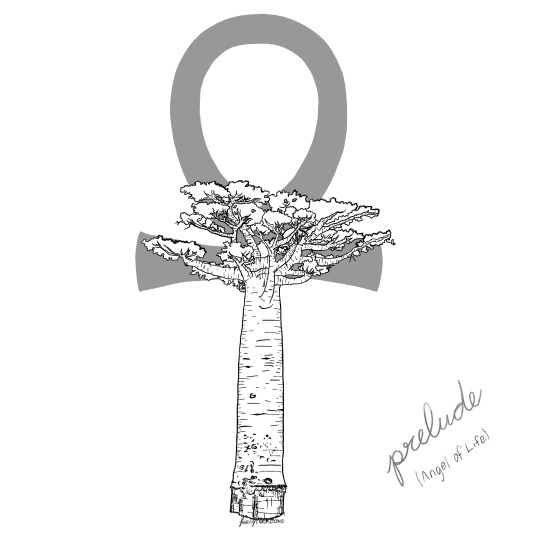

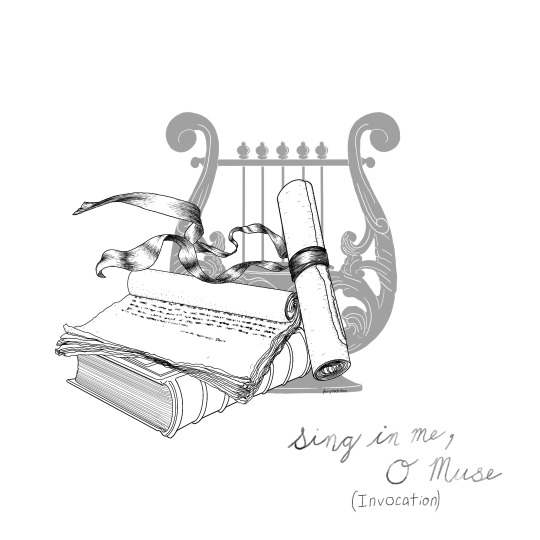





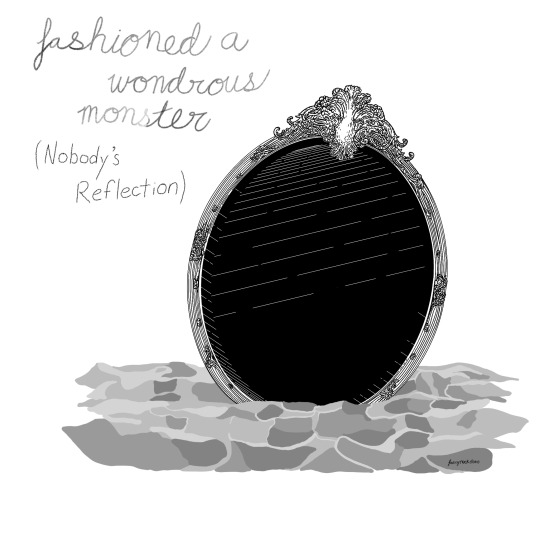



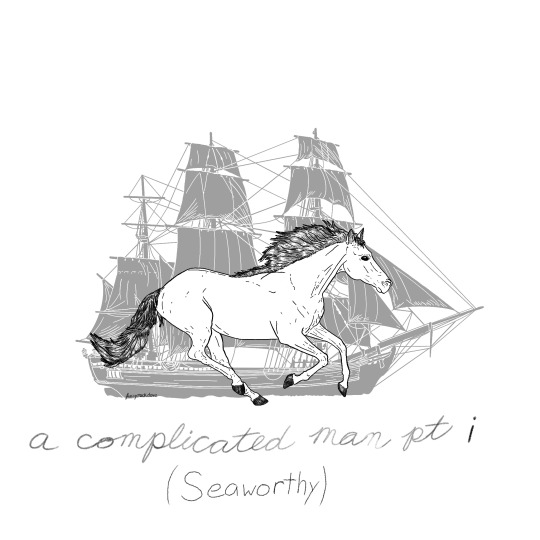
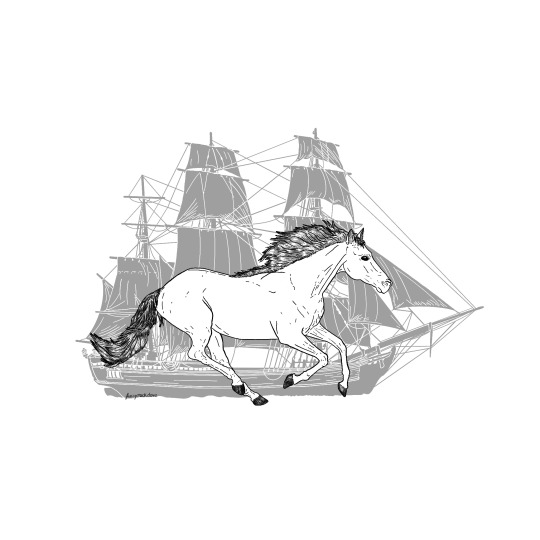



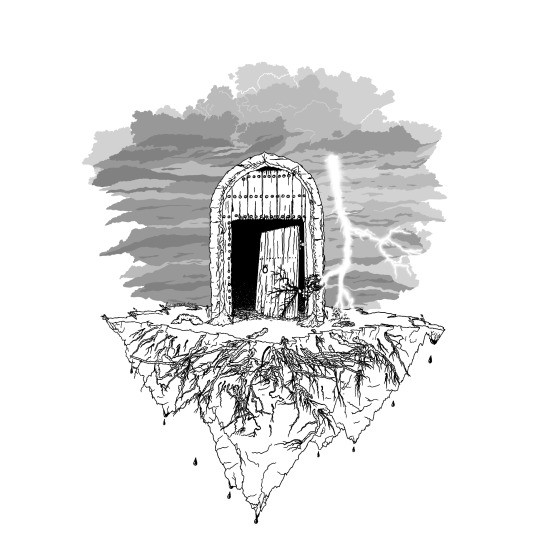



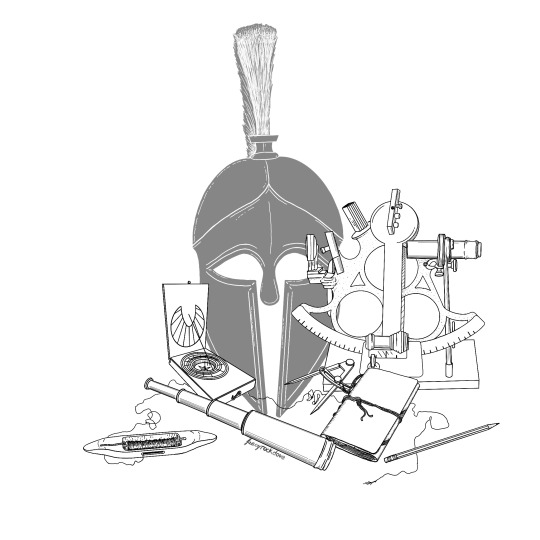


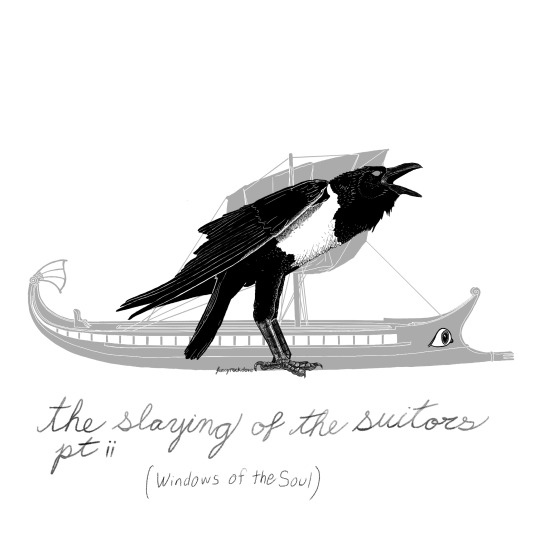
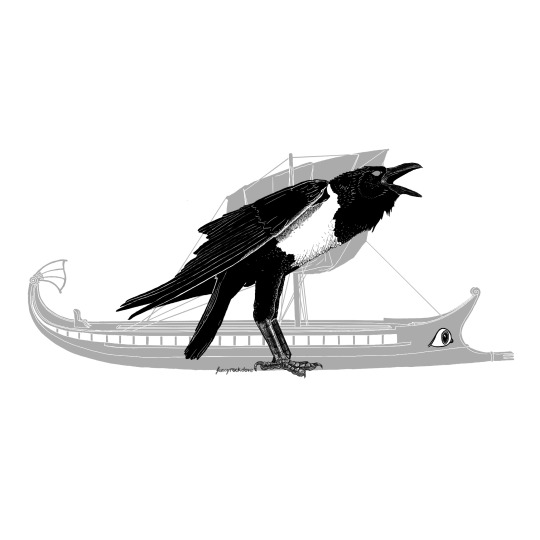
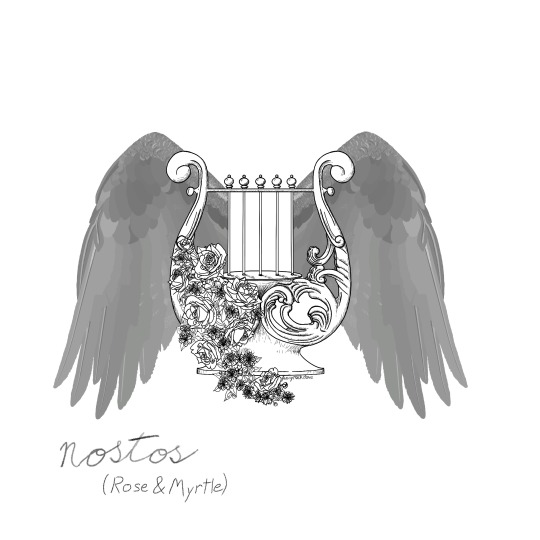

Ch 1: Baobabs are some of the oldest living flowering plants on the planet and can live up to two millennia. I have a lot of feelings about the sheer volume of life these trees can contain (both spatially and in time) and what that means for how we look at them.
Ch 2: If Abel were looking to avoid anachronism, he could still absolutely have left out books that were machine-printed with moveable type, but they'd probably have to have been in Chinese or Korean, from somewhere that had already widely adopted the technology by the 14th century.
Ch 3: Homer's works contain what is believed to be the first written mention of apples in Ancient Greece. Its writing is about as many centuries removed from the events of the Odyssey as the events of this chapter are from the first recorded mention of apples in England.
Ch 4: An ink quill is definitely more aesthetic, but graphite had actually been discovered in England and pencils invented in the decades prior to Shakespeare's first writings. It's entirely possible he could've been jotting down quick notes with a pencil like any stagehand today.
Ch 5: Though Corinthian style architecture is named for the Greek city of Corinth, with which it's associated, its inventor Callimachus is actually thought to be Athenian. The spiny, curling acanthus leaves used in its motifs are generally associated with long life, immortality, and rebirth. Go figure.
Ch 6: Symbolically, clovers are a sign that others are thinking of you. They're associated with good fortune, and apparently also male energy, and seen as a sign of protection. Excellent Fiddler's Green groundcover here.
Ch 7: Three-masted, fully-rigged ships became common in Europe by the 16th or 17th centuries during the Age of Sail because the extra space for sails became more necessary with the increase in open-ocean voyages. Making them the go-to type of vessel for both trade and exploration.
Ch 8: The simple but effective design of drop spindles is largely unchanged from their first documented use in the first century CE. there's evidence of their use for spinning (making a single, stronger thread from many disparate fibers) dating back at least to the advent of agriculture, some 10,000 years ago. Definitely what I picture Clotho using.
Ch 9: The fractal, branching structures of roots, lightning, and Lichtenberg figures are all self-similar: you can get much closer and they'll still appear very similar or identical to the way they were at a distance.
Ch 10: The throne room scenes of Sandman were shot in Guildford Cathedral. The Dreaming's Castle was intentionally designed to be a mashup of a whole ton of architectural styles, but the facade and throne room definitely feel gothic or neo-gothic. It's been a classic for centuries and the gothic-style window is definitely the kind I picture Hob's room having, at least on days the castle's feeling a bit fancy.
Ch 11: The item at the front left there is a weaving shuttle. According to Artemidorus, while dreaming of most kinds of looms indicates that you should expect rest, dreaming of a warp-weighted loom -- the kind which was common in bronze-age Greece and enables multiple people to work together on the weaving -- indicates an upcoming journey.
Ch 12: I feel like I've already talked about the symbolism of this one elsewhere, so for this one, instead of a fact, a comment (that I found fun): The binding circle in this only shows up in areas covered by the puddle of the Dreaming Sea, the means by which the nature of the "gilded ring" was elucidated. :)
Ch 13: Greek ships often had eyes on their bow, which among other things, was intended to imbue them with some will and ability to avoid obstacles. The Argo famously had eyes and also some innate awareness/intelligence, and could actually speak to the crew.
Ch 14: While Calliope, muse of epic poetry and eloquence (and the one invoked at the beginning of the Odyssey) is associated with a book, scroll, or tablet, Erato, muse of romantic poetry and love stories, is depicted in crowns of rose and myrtle. My title for this one was very nearly just (Invocation pt. ii). Also, I have a headcanon that Dream has only seen very bad performances of the Odysseyif ( he's seen any at all) since antiquity. Any show that literally begins by calling his ex is something he's not gonna stay for unless he's really sure she won't actually show up.
Whew! thanks to anyone who actually read to the end of my rambling here! Clearly this whole story has been really, really fun to just turn over in my mind. Cool stuff just keeps falling out of it! Since I would literally be two photos under Tumblr's limit on this post otherwise, how about a couple bonus alternate versions at the end here? Because why not?? I added some red accents to a couple of these for fun, and though it doesn't fit the for the chapter headings, I do think it looks cool!
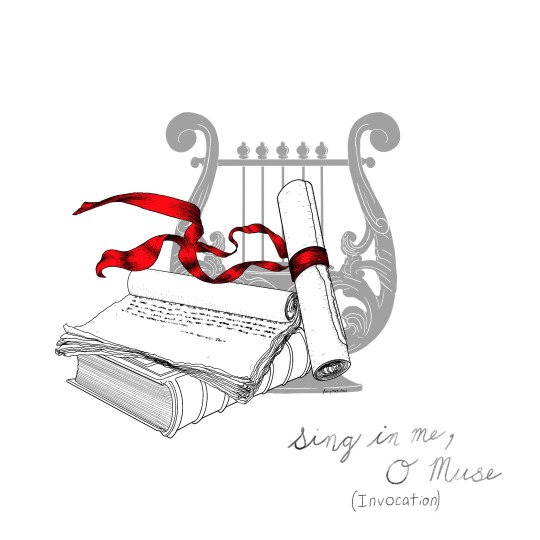
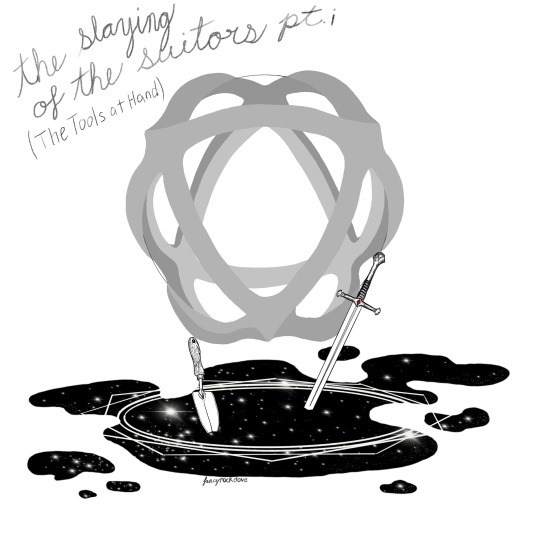
#Maybe Sprout Wings#fic rec#my art#the sandman#hob gadling#dream of the endless#long post#sorry?#how do I write art posts idk#dreamling
80 notes
·
View notes
Text
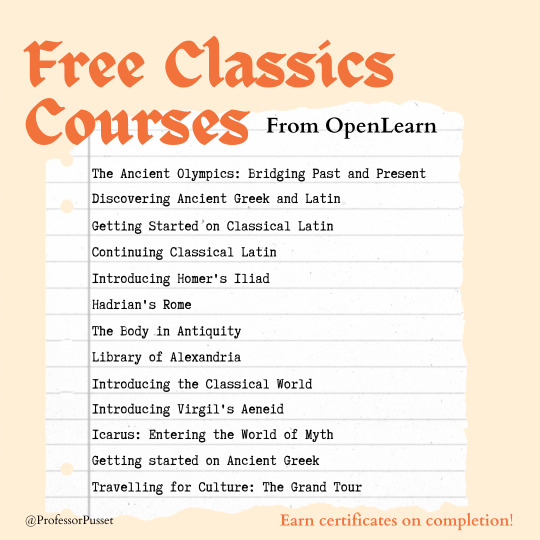
Free Classics Courses - With Certificates!
Studying "the classics" is a rich, rewarding and thoroughly enjoyable experience. Unfortunately these days, many of us lack the opportunity or resources to integrate ancient civilisations and languages into our formal education.
I, for one, am forever grateful that the advent of the digital age heralded new and interesting ways for society to share a wealth of information. Since the early noughties, I've tracked down free online courses in areas of personal interest. Naturally, the Classics is a subject I gravitated towards, and it saddened me to notice that over time free courses in the arts and humanities dwindled in favour of modern, digital, knowledge.
However, I am gladdened to share that OpenLearn (a branch of The Open University) have a growing selection of free Classics courses! All of these courses offer a free certificate to download and print on completion, and are drawn from the various undergraduate courses provided by the university proper.
These courses vary in length and difficulty, but provide an excellent starting point for anyone interested in the Classics, or who would like to sample university level content before committing to a more formal course of study.
Here is a full list of courses in the Classics category at OpenLearn, though I strongly suspect more will be added over time:
The Ancient Olympics: bridging past and present
Highlights the similarities and differences between our modern Games and the Ancient Olympics and explores why today, as we prepare for future Olympics, we still look back at the Classical world for meaning and inspiration.
Discovering Ancient Greek and Latin
Gives a taste of what it is like to learn two ancient languages. It is for those who have encountered the classical world through translations of Greek and Latin texts and wish to know more about the languages in which these works were composed.
Getting started on classical Latin
Developed in response to requests from learners who had had no contact with Latin before and who felt they would like to spend a little time preparing for the kind of learning that studying a classical language involves. The course will give you a taster of what is involved in the very early stages of learning Latin and will offer you the opportunity to put in some early practice.
Continuing classical Latin
Gives the opportunity to hear a discussion of the development of the Latin language.
Introducing Homer's Iliad
Focuses on the epic poem telling the story of the Trojan War. It begins with the wider cycle of myths of which the Iliad was a part. It then looks at the story of the poem itself and its major theme of Achilles' anger, in particular in the first seven lines. It examines some of the characteristic features of the text: metre, word order and epithets. Finally, it explores Homer's use of simile. The course should prepare you for reading the Iliad on your own with greater ease and interest.
Hadrian's Rome
Explores the city of Rome during the reign of the emperor Hadrian (117-38 CE). What impact did the emperor have on the appearance of the city? What types of structures were built and why? And how did the choices that Hadrian made relate to those of his predecessors, and also of his successors?
The Body in Antiquity
Will introduce you to the concept of the body in Greek and Roman civilisation. In recent years, the body has become a steadily growing field in historical scholarship, and Classical Studies is no exception. It is an aspect of the ancient world that can be explored through a whole host of different types of evidence: art, literature and archaeological artefacts to name but a few. The way that people fulfil their basic bodily needs and engage in their daily activities is embedded in the social world around them. The body is a subject that can reveal fascinating aspects of both Greek and Roman culture it will help you to better understand the diversity of ancient civilisation.
Library of Alexandria
One of the most important questions for any student of the ancient world to address is 'how do we know what we know about antiquity?' Whether we're thinking about urban architecture, or love poetry, or modern drama, a wide range of factors shape the picture of antiquity that we have today. This free course, Library of Alexandria, encourages you to reflect upon and critically assess those factors. Interpreting an ancient text, or a piece of material culture, or understanding an historical event, is never a straightforward process of 'discovery', but is always affected by things such as translation choices, the preservation (or loss) of an archaeological record, or the agendas of scholars.
Introducing the Classical World
How do we learn about the world of the ancient Romans and Greeks? This free course, Introducing the Classical world, will provide you with an insight into the Classical world by introducing you to the various sources of information used by scholars to draw together an image of this fascinating period of history.
Introducing Virgil's Aeneid
This free course offers an introduction to the Aeneid. Virgil’s Latin epic, written in the 1st century BCE, tells the story of the Trojan hero Aeneas and his journey to Italy, where he would become the ancestor of the Romans. Here, you will focus on the characterisation of this legendary hero, and learn why he was so important to the Romans of the Augustan era. This course uses translations of Virgil’s poem, and assumes no prior knowledge of Latin, but it will introduce you to some key Latin words and phrases in the original text.
Icarus: entering the world of myth
An introduction to one of the best-known myths from classical antiquity and its various re-tellings in later periods. You will begin by examining how the Icarus story connects with a number of other ancient myths, such as that of Theseus and the Minotaur. You will then be guided through an in-depth reading of Icarus’ story as told by the Roman poet Ovid, one of the most important and sophisticated figures in the history of ancient myth-making. After this you will study the way in which Ovid’s Icarus myth has been reworked and transformed by later poets and painters.
Getting started on ancient Greek
A taster of the ancient Greek world through the study of one of its most distinctive and enduring features: its language.
The course approaches the language methodically, starting with the alphabet and effective ways to memorise it, before building up to complete Greek words and sentences. Along the way, you will see numerous real examples of Greek as written on objects from the ancient world.
Travelling for Culture: The Grand Tour
In the eighteenth century and into the early part of the nineteenth, considerable numbers of aristocratic men (and occasionally women) travelled across Europe in pursuit of education, social advancement and entertainment, on what was known as the Grand Tour. A central objective was to gain exposure to the cultures of classical antiquity, particularly in Italy. In this free course, you’ll explore some of the different kinds of cultural encounters that fed into the Grand Tour, and will explore the role that they play in our study of Art History, English Literature, Creative Writing and Classical Studies today.
#classics#ancient greece#greek mythology#classical studies#classical education#greek#latin#the grand tour#dark academia#light academia#dark academia guide#homer#virgil#openlearn#free courses#online education
182 notes
·
View notes
Text
Timeline of the Lost Cities — Part One
Notes/Reminders:
The term ‘present day’ refers to 2000 CE
All the science is very dubious and very fake
Variant theories/thoughts/rambles are welcome and encouraged!
Link to masterpost
TOTLC — PART ONE — The Beginning of the Earth and the Origins of the Intelligent Species
The earth begins as it does in our world. It is round, and it follows more or less the same laws. It is some 4.6 billion years old.
The first of the Intelligent Species are the dwarves — they come first because rock comes first, and they are, in a way, closest to the earth as it was in its beginning. They are elusive, and their oldness may account for their low populations in the present day— they may have died in large earthquakes, volcanic eruptions and suchlike. They do not usually die of natural causes, but they are solitary and reproduce infrequently. The estimate of 329 living dwarves that canon gives us is probably short of the real number. They do not reproduce in the same way as mammals — their young are encased in stone to grow, and break out of it when they are full-grown.
Next come the gnomes, which develop as trees begin to develop. They are long-lived creatures as well, and communicate often with the plant life around them. It is gnomes that first come up with the concept of the Timeline to Extinction. They do their best with the dwarves’ help to protect all living things in the world, ensuring that they survive and grow safely. Their main method of transportation is the root-system, and they are the first Intelligent Species to travel around the whole world — before the advent of light leaping, they were the ones facilitating transport around the world. They often plant their young as a seed, and when they reach a certain stage of life, the young uproot their feet and begin to walk. Their deaths are similar, in that they take root into the ground.
The third Intelligent Species to evolve is that of the trolls. This has been reasoned considering their size and that they canonically hatch out of hives and are quite large, putting one in mind of prehistoric reptilian or amphibious creatures. This reasoning would also make sense if they came into being before mammals. They learn to ride large animals such as dinosaurs, and use them for transport — many of them ride flying reptiles, and travel that way rather than via root systems.
The goblins come next. This is reasoned by the fact that they are described as ‘reptilian’, mainly in comparing Sandor to an armadillo in canon (armadillos are mammals, but seem somewhat reptilian in appearance). This means that they could have come into existence at some point before mammals becoming common and some point after the mass (almost) extinction of many reptilian creatures. They work closely with dwarves and gnomes, and are perhaps the first to discover metalsmithing. They have great endurance, and usually walk to travel, although some have been known to use mounts such as large horses and elephants.
Next are the ogres, which possibly have evolved from a large species of primate. They are cave-dwellers, and their forays into bioluminescence and the use of microbes begin quite early (this may have something to do with the gnomish influences on their ancient society, and the way in which this would have emphasised the importance of life in all its forms). Their society is influenced by dwarves in their habitation, and by goblins in some of their weaponry. However, they also have unique customs.
The most primitive elves and humans begin to appear in Africa about seven million years ago. Elves’ lives grow longer as they evolve, while humans separate from them and evolve to have shorter lifespans. Humans do not generally come under much influence of the other species at first, nor do the elves. Elves and humans begin to move out of Africa 1.8 million years before the present day, and spread over the world. Elves’ initial vocabularies are starting to become standardised (their communities develop language a good deal before humans, as it is instinctive to them). Writing has not yet been developed by the Elves, although the other species (save for the gnomes) have some form of writing and/or record keeping. The first abilities among elves start appearing about 500,000 years ago, and humans as archaic homo sapiens begin appearing around 300,000 years ago.
Up Next: The Intelligent Species and a Breakdown of Their Ancient Customs
#timeline of the lost cities#kotlc#kotlc theories#keeper of the lost cities#kotlc gnomes#kotlc dwarves#kotlc ogres#kotlc goblins#kotlc trolls#kotlc elves#kotlc humans#That last one was NOT a tag I was ever expecting to tag but well
17 notes
·
View notes
Text


Squared Vessel, "Vase of the Eleven Gods". Maya, 755–780 CE. Artist: Lo’ Took’ Akan (?) Xok. LACMA
"Seated on a throne covered by a jaguar pelt, an old, cigar-smoking, jaguar-eared god presides over an assembly of ten deities. The associated hieroglyphic caption is brief: groups of named gods were aligned at K’inchil, or Great Sun Place, on August 11, 3114 BCE. The consequences of the gathering are unclear, but this mythical event was among those that set the world in order and created the conditions for the advent of people, cities, and kingdoms."
4 notes
·
View notes
Text
Someone on Reddit made the mistake of saying, "Teach me how this conflict came about" where I could see it.
Let me teach you too.
The common perception is that Jews came out of nowhere, stole Palestinian homes and kicked Palestinians out of them, and then bombed them for 75 years, until they finally rebelled in the form of Hamas invading Israel and massacring 22 towns in one day.
The historical reality is that Jews have lived there continuously for at least 3500 years.
There are areas, like Meggido iirc, with archeological evidence of continuous habitation for 7,000 years, but Jewish culture as we recognize it today didn't develop until probably halfway through that.
Ethnic Jews are the indigenous people of this area.
Indigeneity means a group was originally there, before any colonization happened, and that it has retained a cultural connection to the land. History plus culture.
That's what Jews have: even when the diaspora became larger than the number of Jews in Israel, the yearning to return to that homeland was a daily part of Jewish prayer and ritual.
The Jewish community in Israel was crushed pretty violently by the Roman Empire in 135 CE, but it was still substantial, sometimes even the majority population there, for almost a thousand years.
The 600s CE brought the advent of Islam and the Arab Empire, expanding out from Saudi Arabia into Israel and beyond. It was largely a region where Jews were second-class citizens. But it was still WAY better than the way Christian Europe treated Jews.
From the 700s-900s, the area saw repeated civil wars, plagues, and earthquakes.
Then the Crusades came, with waves of Christians making "pilgrimages to the Holy Land" and trying to conquer it from Muslims and Jews, who they slaughtered and enslaved.
Israel became pretty well depopulated after all that. It was a very rough time to live there. (And for the curious, I'm calling it Israel because that's what it had been for centuries, until the Romans erased the name and the country.)
By the 1800s, the TOTAL population of what's now Israel and Palestine had varied from 150,000 - 275,000 for centuries. It was very rural, very sparsely populated, on top of being mostly desert.
In the 1880s, Jews started buying land and moving back to their indigenous homeland. As tends to happen, immigration brought new projects and opportunities, which led to more immigration - not only from Jews, but from the Arab world as well.
Unfortunately, there was an antisemitic minority spearheaded by Amin al-Husseini. Who was very well-connected, rich, and from a politically powerful family.
Al-Husseini had enthusiastically participated in the Armenian Genocide under the Ottoman Empire. Then the Empire fell in World War One, and the League of Nations had to figure out what to do with its land.
Mostly, if an area was essentially operating as a country (e.g. Turkey), the League of Nations let it be one. In areas that weren't ready for self-rule, it appointed France or Britain to help them get there.
In recognition of the increased Jewish population in their traditional, indigenous homeland, it declared that that homeland would again become Israel.
As in, the region was casually called Palestine because that was the lay term for "the Holy Land." It had not been a country since Israel was stamped out; only a region of a series of different empires. And the Mandate For Palestine said it was establishing "a national home of the Jewish people" there, in recognition of "the historical connection of the Jewish people with Palestine and to the grounds for reconstituting their national home in that country."
Britain was appointed to help the Arab and Jewish communities there develop systems of self-government, and then to work together to govern the region overall.
At least, that was the plan.
Al-Husseini, who was deeply antisemitic, did not like this plan.
And, extra-unfortunately, the British response to al-Husseini inciting violent anti-Jewish riots was to put him in a leadership role over Arab Palestine.
They thought it would calm him down and perhaps satisfy him.
They were very wrong.
He went on to become a huge Hitler fanboy, and then a Nazi war criminal. He co-created the Muslim Brotherhood - which Hamas is part of - with fellow fascist fanboy Hassan al-Banna.
He got Nazi Party funding for armed Muslim Brotherhood militias to attack Jews and the Brits in the late 30s, convincing Britain to agree to limit Jewish immigration at the time when it was most desperately needed.
He started using the militias again in 1947, when the United Nations voted to divide the mandated land into a Jewish homeland and a Palestinian one.
Al-Husseini wouldn't stand for a two-state solution. He was determined to tolerate no more than the subdued, small Jewish minority of second-class citizens that he remembered from his childhood.
As armed militias increasingly ran riot, the Arab middle and upper classes increasingly left. About 100,000 left the country before May 1948, when Britain was to pull out, leaving Israel and Palestine to declare their independence.
The surrounding nations didn't want war. They largely accepted the two-state solution.
But al-Husseini lobbied HARD. And by mobilizing the Muslim Brotherhood to provide "destabilizing mass demonstrations and a murderous campaign of intimidation," he got the Arab League nations to agree to invade, en masse, as soon as Britain left.
About 600,000 Arabs fled to those countries during the ensuing war.
Jews couldn't seek refuge there; in fact, most of those countries either exiled their Jews directly, confiscating their property first, or else made Jewish life unlivable and exploited them for underpaid or slave labor for years first.
By the time the smoke cleared and a peace treaty was signed, most of the Arab Palestinian community had fled; there was no Arab Palestinian leadership; many of the refugees' homes and businesses had left had been destroyed in the war; and Israel had been flooded with nearly a million refugees from the Arab League countries and the Holocaust - even more people than had fled the war.
That was the Nakba. The one that gets portrayed as "750,000 Palestinians fled or were expelled!" in the hope that you'll assume they were expelled en masse, their beautiful intact homes all stolen.
Egypt had taken what's now the Gaza Strip in that war, and Jordan took what's now the West Bank - expelling or killing all the Jews in it first.
(Ironically, Jordan was originally supposed to be part of Israel. Britain, inexplicably, cut off what would have been 75% of its land to create Jordan.
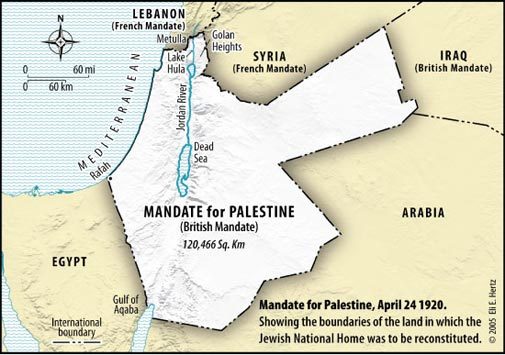
Even more inexplicably, nobody ever talks about it. I've never seen anyone complain that Jordan was stolen from Palestinians. Possibly because Jordan is also the only country that gave Palestinian refugees full citizenship, and it's about half Palestinian now.
Israel is nearly 25% Arab Palestinians with full citizenship and equal rights, so it's not all that different -- but the fundamental difference of living in a country where the majority is Jewish, not Muslim, probably runs pretty deep.)
Anyway: that's why Palestine is Gaza and the West Bank, rather than being some contiguous chunk of land. Or being the land set aside by the U.N. in 1947.
Because Arab countries took that land in 1948, and treated them as essentially separate for 20 years.
Israel got them back, along with the Golan Heights and the Sinai Peninsula, in the next war: 1967, when Egypt committed an act of war by taking control of the waterways and barring Israel from them. It gave the Sinai back to Egypt as part of the 1979 peace accords between Egypt and Israel.
Israel tried to give back the Gaza Strip at the same time. Egypt refused.
Palestine finally declared independence in 1988.
But Hamas formed at about the same time. Probably in response, in fact. Hamas is fundamentally opposed to peace negotiations with Israel.
Again: Hamas is part of a group founded by Nazis.
Hamas has its own charter. It explains that Jews are "the enemy," because they control the drug trade, have been behind every major war, control the media, control the United Nations, etc. Basic Nazi rhetoric.
It has gotten adept at masking that rhetoric for the West. But to friendlier audiences, its leaders have consistently said things like, "People of Jerusalem, we want you to cut off the heads of the Jews with knives. With your hand, cut their artery from here. A knife costs five shekels. Buy a knife, sharpen it, put it there, and just cut off [their heads]. It costs just five shekels."
(Palestinians were outraged by this speech. Palestinians, by and large, absolutely loathe Hamas.
It's just that it's not the same to say that to locals, as it is to say it where major global powers who oppose this crap can hear you.)
Hamas has stated from the beginning that its mission is to violently destroy Israel and take over the land.
It has received $100M in military funding annually, from Iran, for several years. Because Iran has been building a network of fascist, antisemitic groups across the Middle East, in a blatant attempt to control more and more of it: Hezbollah in Lebanon. The Houthis in Yemen.
Iran has been run by a very far-right, deeply antisemitic dictatorship for decades now, which pretty openly wants to take down both Israel and the U.S.
Last year, Iran increased Hamas's funding to $350M.
The "proof of concept" invasion of Israel that Hamas pulled off on October 7th more than justifies a much bigger investment.
Hamas has publicly stated its intention to attack "again and again and again," until Israel has been violently destroyed.
That is how this conflict came about.
A Nazi group seized power in Gaza in 2007 by violently kicking the Palestinian government out, and began running it as a dictatorship, using it to build money and power in preparations for exactly this.
And people find it shockingly easy to believe its own hype about being "the Palestinian resistance."
As well as its propaganda that Israel is not actually targeting Hamas: it's just using a literal Nazi invasion and massacre as an excuse to randomly commit genocide of the fraction of Palestine it physically left 20 years ago.
Despite the fact that Palestinians in Gaza have been protesting HAMAS throughout the war.

#free palestine#free gaza from hamas#free everyone from hamas it's awful#we want to live movement#free gazans group#center the people directly affected#Ironically it's almost exclusively zionists who know about and support the actual activists in Palestine#because Zionism is a real Jewish term for self-determination not something you can redefine to demonize us#and the pro-hamas movement is inherently both antisemitic and anti-Palestinian#wall of words#jumblr#jewish history#palestinian history
10 notes
·
View notes
Text
Writing Patterns (Tag Game)
Rules : list the first line of your last 10 (posted) fics and see if there is a pattern !
Alright @stardustloki @here-be-bec since you both asked for it, here it is xD
Some of those works are original works (because I don't have enough fanfics) and are also in french (but I'm going to put the translation too because I'm nice like that 😋)
1. "Fox ?" (A fox somewhere is hiding)
2. "Fox didn't understand" (Just this once)
And for the french ones :
3. "Je suis un casque." I am a helmet. (Le Casque.)
The next ones are all from a collection I did as a Advent Calendar two Christmases ago (Les Histoires de l'Avent). They're the seven last stories and take place in the same world, that's why the character of the Bard come back all the time (she's the one telling the stories.)
4. "- Ou démonstration de l'incapabilité des fées à gérer le genre humain, s'amusa la barde." -Or an exemple of the faes incapacity to handle the human race, the bard joked.
5. "La barde avait le regard perdu, scrutant des vérités accessibles à elle seule." The bard was staring into space, observing truths only she could know.
6. "La barde souria doucement, en observant les flocons de neige voler contre les fenêtres." The bard smiled softly, watching the snowflakes falling on the windows.
7. "La barde entama un air de voyage et de liberté, portant l'aura de ces choses qui ont survécu au passage du temps et qui n'avaient rien fait pour éviter les dangers." The bard started a song of travel and freedom, with the aura of those things which survived the passage of time and never tried to run away from danger.
8. "C'était au début du monde, sûrement." It was at the very beginning of the world, most likely.
9. "La barde faisait face à une taverne quasi vide." The bard was facing a practically empty tavern.
10. "La barde avait vu juste : la taverne était bondée" The bard had been right : the tavern was crowed.
So, I have a tendency to expose things at the beginning (a bit fairy tale style 🤔 which is good since that was what I was aiming for in the collection). Or I'm going right into things, but it's rarer. It's good to know !
I'm not tagging anyone but if you want to play feel free to say I tagged you ! Would love to see your answers ☺️
3 notes
·
View notes
Text
Les Origines de la pensée grecque- The Origins of Greek Thought

Jean-Pierre Vernant - Les Origines de la Pensée Grecque, Presses Universitaires de France (PUF) 1962, republished several times since then.
" L'ambition [de cet essai] n'était pas de clore le débat par une étude exhaustive mais de le relancer... j'ai tenté de retracer les grandes lignes d'une évolution qui, de la royauté mycénienne à la cité démocratique, et marqué le déclin du mythe et l'avènement de savoirs rationnels. " En quoi consiste le miracle grec ? Quelles sont les innovations ayant marqué ce que nous appelons la pensée grecque et pourquoi se sont-elles produites dans ce monde grec ? Le mérite de Jean-Pierre Vernant est de réaliser une synthèse personnelle et accessible sur un sujet controversé où s'affrontent de nombreux hellénistes. Publié en 1962 dans la collection Mythes et religions, dirigée par Georges Dumézil, l'auteur a lui-même, à l'occasion d'une réédition parue vingt-cinq ans plus tard, réactualisé dans une longue préface certaines de ses interprétations (from the edition of 2013).

Jean-Pierre Vernant's concise, brilliant essay on the origins of Greek thought relates the cultural achievement of the ancient Greeks to their physical and social environment and shows that what they believed in was inseparable from the way they lived. The emergence of rational thought, Vernant claims, is closely linked to the advent of the open-air politics that characterized life in the Greek polis. Vernant points out that when the focus of Mycenaean society gave way to the agora, the change had profound social and cultural implications. "Social experience could become the object of pragmatic thought for the Greeks," he writes, "because in the city-state it lent itself to public debate. The decline of myth dates from the day the first sages brought human order under discussion and sought to define it.... Thus evolved a strictly political thought, separate from religion, with its own vocabulary, concepts, principles, and theoretical aims."
Jean-Pierre Vernant The Origins of Greek Thought, Cornell University Press, 1984
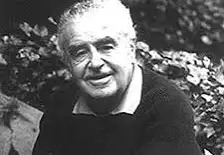
Jean-Pierre Vernant (1914-2007), known with the pseudonym Colonel Berthier as commander of units of the French resistance during WWII, was a French historian and anthropologist specialized in ancient Greece.
#jean pierre vernant#ancient greece#les origines de la pensée grecque#the origines of greek thought#classics
3 notes
·
View notes
Text
Tongues Through Time
The history of cunnilingus is deeply intertwined with cultural, social, and historical contexts. In ancient times, depictions of sexual practices, including cunnilingus, were often found in art, literature, and historical accounts. In ancient India, the Kama Sutra, a renowned text on human sexuality believed to have been composed around the 2nd century CE, offered detailed instructions on various sexual techniques, including oral pleasure for women. Similarly, ancient Chinese texts, such as the Taoist sexual manuals, explored the concept of sexual harmony, emphasizing the importance of mutual satisfaction.
Moving to ancient Greece, the practice of cunnilingus was referenced in some comedic plays and erotic poetry, suggesting that it held a place in the sexual repertoire of the time. However, it is crucial to note that the acceptability and perception of such practices varied across cultures and periods.
In medieval Europe, attitudes towards sexuality became more conservative due to the influence of Christianity. The Church's teachings often discouraged explicit discussions of sexual pleasure, and this had a suppressive effect on the open exploration and documentation of sexual practices, including cunnilingus.
The Renaissance period witnessed a shift in societal attitudes towards human sexuality, with a renewed interest in the human body and its pleasures. Artworks from this time, including paintings and sculptures, depicted erotic scenes that suggested a more liberated approach to sexual expression.
The 18th and 19th centuries saw a mix of repression and exploration. While social norms remained conservative in many places, the times also brought about intellectual and cultural shifts that influenced a more open discourse on sexuality. However, explicit discussions of cunnilingus were still often considered taboo.
The 20th century marked significant changes in societal attitudes towards sexuality. The sexual revolution of the 1960s and 1970s, coupled with advancements in contraceptive methods, paved the way for a more liberated approach to sexual expression. Cultural shifts during this period encouraged open discussions about previously taboo subjects, including oral sex.
In contemporary times, discussions about cunnilingus are more open and inclusive. With the advent of the internet and the rise of sex-positive movements, there is a greater emphasis on communication, consent, and the celebration of diverse sexual practices. Modern attitudes towards cunnilingus reflect a more inclusive and informed understanding of human sexuality, challenging historical taboos and promoting healthy, consensual sexual exploration.
If you enjoyed this, I invite you to give my podcast a listen 'Chatting With The Lightkeeper,' a top 25% most-followed podcasts on Spotify but available on all the major podcasting apps and follow my socials for more exclusive content: Instagram, Facebook, and X (formerly Twitter) for a deeper dive into the wonderful world of D/S.
As with all of my thoughts, please see this disclaimer.
©TLK2024
#bd/sm blog#bd/sm community#bd/sm daddy#bd/sm kink#bd/sm lifestyle#bd/sm relationship#d/s#d/s community#d/s relationship#dom/sub#my writing
6 notes
·
View notes
Text

🔍 Denying the Greatest Event in History: A Critical Insight
In recent times, we've witnessed a subtle yet significant shift in our calendar system - a move from BC/AD to BCE/CE. Here's why this change is more than just a matter of terminology:
▶️ Historical Connection to Christ's Birth: The BC/AD system has been historically centred around the birth of Christ, a tradition that has been upheld for centuries.
▶️ Origins of the 'Common Era' Term: Initially introduced by Johannes Kepler to distinguish regnal years, the term "Common Era" was adopted to emphasize the calendar's focus on Christ's birth.
▶️ Academic Influence: In the past few decades, the academic sphere has been pushing for this change, aiming to erase Christian thinking and promote materialism under the guise of 'science'.
▶️ Hypocrisy of the Change: Despite the change in terminology, the Gregorian calendar still revolves around the birth of Christ, making this shift somewhat hypocritical and an attempt to rewrite history.
▶️ Impact on the Youth: This change mirrors strategies used in the past to influence the thoughts of the younger generation, potentially leading them away from the faith of their ancestors.
▶️ Non-Christian Communities' Perspective: Interestingly, leaders from non-Christian communities have expressed no offence to the BC/AD system, debunking the notion of political correctness requiring this change.
▶️ Positive Impact of CMI: Many have found clarity and understanding through CMI's efforts in upholding Biblical truths and historical facts.
As we approach the Advent season in the coming months, let's stand firm in our faith and continue to be witnesses to the undeniable impact of Christ's birth in history.
See the full article here: https://creation.com/denying-the-greatest-event-in-the-history-of-the-world?fbclid=IwAR3F-lGfCr1ahJxkAkFD13ZjZzCpezCHsQH7ShZrTem0sUdIV6OQEp-jM6w
4 notes
·
View notes